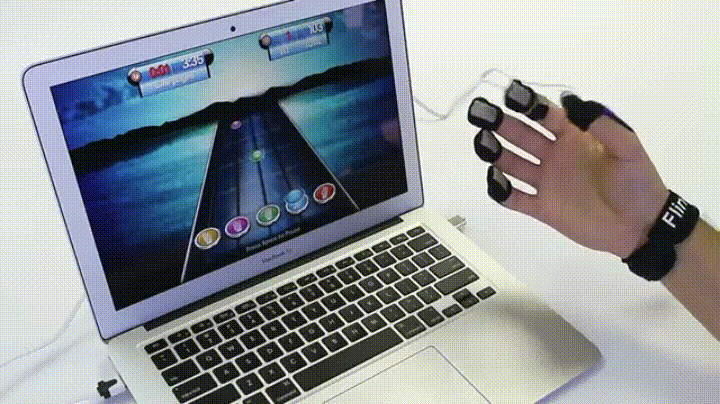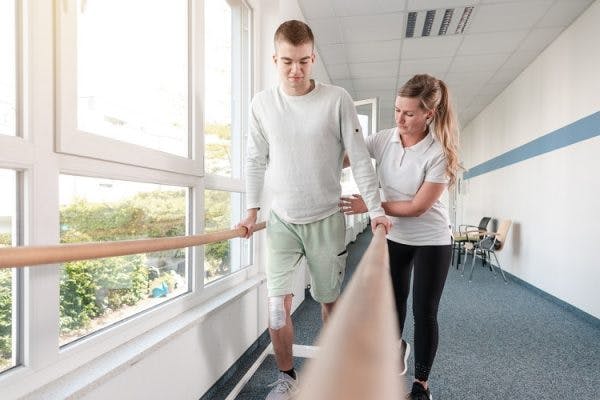If you’ve lost hand function after a spinal cord injury, learning how to use tenodesis grasp can help you become more independent.
Tenodesis is a function of the wrist/hand that we all have normally. When the wrist is flexed (bent down), the fingers should straighten and feel loose. In contrast, when the wrist is extended (bent upwards), the fingers should start to curl together and form a tighter grip.
Because of this natural function tenodesis can be used as a technique to allow spinal cord injury patients with hand paralysis to grasp and release objects by adjusting the positioning of their wrists.
This article will explain how spinal cord injury patients can utilize tenodesis to maximize their independence and share some tips to enhance its effects.
How Tenodesis Grasp Works
Tenodesis grasp is ideal for spinal cord injury patients with limited hand function because it does not require active movement of the fingers. By simply moving the wrist up and down, passive grasp and release can be performed.
Tenodesis grasp is possible because the tendons that allow you to bend and straighten the fingers run through the wrist to the forearm. Moving the wrist pulls the tendons, which causes passive movement of the fingers.
Now that you understand the mechanisms behind tenodesis grasp, let’s discuss how spinal cord injury patients can utilize it to become more functionally independent.
Using Tenodesis After Spinal Cord Injury to Boost Independence
Tenodesis may not be ideal for all spinal cord injury patients, primarily because some upper extremity function is necessary to move the wrists. Similarly, those who have unaffected hand functions will not need to use tenodesis at all.
Generally, those with C6 or C7 spinal cord injuries can benefit most from tenodesis grasp because they can control their wrist movements, but have limited finger control. The biomechanical pulling allows individuals to grab and release items despite having limited or no control over their hands.
Tenodesis grip can help SCI patients perform everyday activities such as brushing their teeth, using silverware, and turning doorknobs.
Check out the video below to see how SCI survivor Mason uses tenodesis to be more independent!
Up next, we’ll discuss some dos and don’ts for enhancing tenodesis grasp.
How to Optimize Tenodesis Grip After Spinal Cord Injury
Tenodesis can significantly improve the quality of life of spinal cord injury patients with limited or no hand functions.
Below, we’ll go over 3 easy ways to maximize the effects of tenodesis grasp:
1) Wear a Tenodesis Splint
A tenodesis splint is an orthotic device that spinal cord injury patients can wear over their hand and forearm. It helps guide grasp and release movements, providing the extra support individuals may need to perform tasks on their own.
Typically, tenodesis splints for spinal cord injury patients are custom-made to perfectly fit each individual’s hand and wrist. This helps ensure that the orthosis is comfortable, stays put, and does not constrict blood flow. Talk to your occupational therapist to see if a tenodesis splint would benefit you.
Check out the video below to see how a tenodesis splint helps support finger movements.
2) Move the Wrist Through Its Entire Range of Motion
Another way to enhance tenodesis is to prevent stiff wrists by regularly rotating them in circular motions. This will guide the joints through their entire range of motion and keep them flexible.
While doing so, it is very important that SCI patients make sure that their fingers are curled in. Raising the wrist with extended (straight) fingers will overstretch the tendons and loosen grip strength.
3) Stretch Fingers with Wrist Flexed
Spinal cord injury patients should also stretch their fingers to prevent stiffness and enable the hand to wrap around larger objects when relaxed.
As mentioned above, make sure that the wrist is flexed (bent down, bringing your fingertips closer to the inside of your wrist), so that there is no resistance. The fingers should feel loose so you can passively move them without compromising tension in the tendons.
In the next section, we’ll discuss whether SCI patients must permanently rely on tenodesis or if hand functions can return.
Is It Possible to Recover Hand Function After Spinal Cord Injury?
Tenodesis grasp helps spinal cord injury patients compensate for limited hand functions. However, depending on the severity of the spinal cord injury, it may be possible to recover hand functions.
Thanks to neuroplasticity, undamaged neural pathways can adapt by rewiring themselves and sprouting new axons. Generally, individuals with milder spinal cord injuries have more positive recovery outlooks because they have more spared neural pathways, and therefore more spared movement and sensation. However, there are varying degrees of severity of incomplete spinal cord injuries. Therefore, functional improvements will vary.
The best way to promote neuroadaptive changes in the spinal cord is to repetitively practice weakened movements. Therefore, individuals with weak hand control should practice hand exercises, within the confines mentioned above to avoid overstretching the fingers. The more they practice using weak functions, the more rewiring occurs and the stronger the neural pathways for those functions can become.

Performing enough repetitions to stimulate neuroplasticity can be challenging as patients get bored of constantly practicing the same movement. FlintRehab’s MusicGlove combines gaming, hand therapy, and music to help keep individuals engaged and performing the repetitions they need to improve grasp and release functions. In fact, MusicGlove is clinically proven to improve hand functions in just 2 weeks!
SCI patients with no hand control can stimulate the spinal cord by continuing to use tenodesis grasp. Every movement (even passive ones) stimulates the spinal cord, and as long as spared neural pathways at your level of injury exist, functional improvements are possible.
Understanding Tenodesis and Spinal Cord Injury
Tenodesis grasp can significantly improve a spinal cord injury patient’s ability to accomplish everyday activities on their own. By moving the wrists up and down, individuals can successfully control the opening and closing of their hands.
Hopefully, this article helped you better understand how tenodesis grasp works as well as how individuals with SCI can use it to boost their independence. Good luck!
Featured Image: iStock/fizkes











